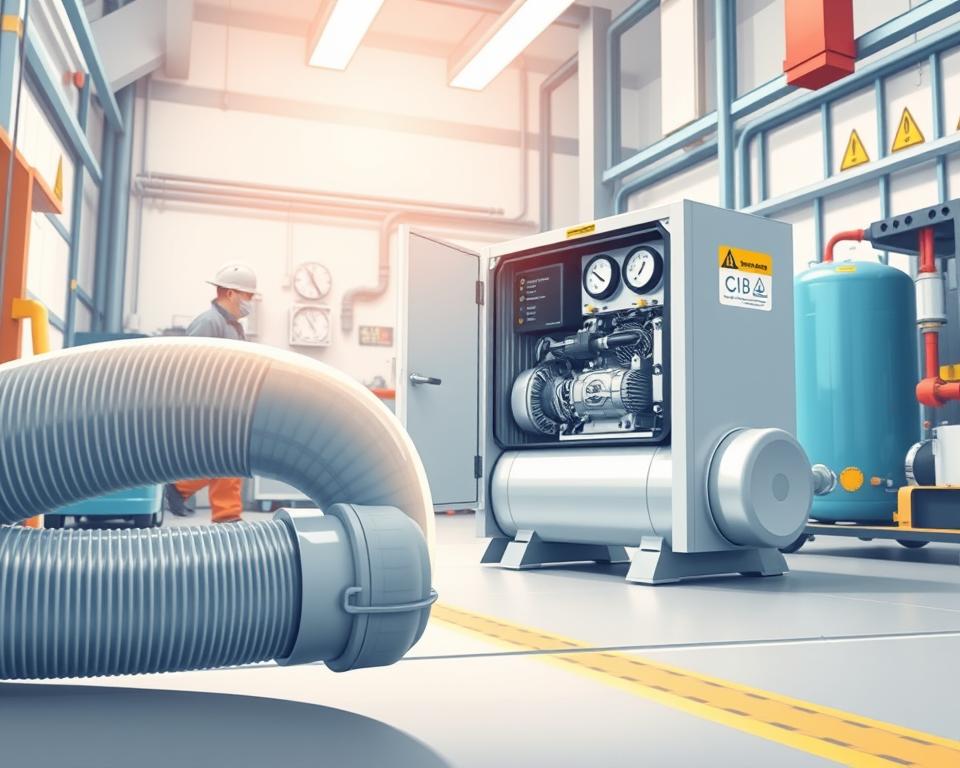PVC Pipe for Air Compressor Lines: Your Complete Guide
You might be surprised to learn that a failure in a compressed air system can unleash power on par with dynamite. Many facilities still use piping systems made from risky materials, unaware of the dangers. This guide explains why safety should come first when using PVC air lines.
Even as interest rises, OSHA bans these materials for above-ground compressed air. Repeated contact with compressor oil and thermal cycling makes them brittle, causing explosive failures. Safe-rated pressures can still result in deadly bursts.
Turn to Installation Parts Supply for sturdy aluminum systems. Using approved materials saves you from fines and enhances safety. Let’s explore how to build a safer system.

Significant Notes
- Explosion danger leads OSHA to outlaw some pipe materials.
- Heat and cold swings slashes claimed pressure capacity.
- Long-term exposure makes pipes prone to brittle breaks.
- Switching to aluminum vastly improves safety.
- Spending on correct materials avoids penalties and injuries.
Why You Shouldn’t Use PVC for Compressed Air
PVC makers caution never to employ it in high-pressure air setups. Unlike water, compressed air stores explosive energy—a ruptured line can release force comparable to dynamite. Select your piping wisely to avoid deadly failures.
- Brittleness: Sub-freezing temperatures turn materials brittle, increasing fracture risks.
- Adhesive failures: Oil contamination and heat cycles break down glue bonds.
- Misleading ratings: Ratings halve by 110°F, a common shop temperature.
OSHA cites a $110,000 fine after a facility’s piping shattered, injuring workers. Compression heating lowers allowable pressure even more—often ignored.
“Above-ground use of certain plastics for compressed air violates OSHA standards due to explosion risks.”
Steel and aluminum curve under stress instead of shattering. PVC shards fly far and fast, causing collateral damage.
Constant temperature swings in shops speed up pipe aging. Over 10 years, UV exposure and chemical interactions further compromise integrity, turning minor leaks into major hazards.
Recommended Piping Materials for Compressed Air
Modern aluminum systems beat old-school piping on both safety and performance. They leak 90% less than black iron, making them ideal for today’s shops. Lightweight, rust-proof aluminum stands up to years of service.
Threadless modular aluminum assemblies speed assembly. Installation Parts Supply offers pre-assembled sections that snap together. A Midwest auto plant cut labor costs by 40% after switching to this system.
- Copper: Copper’s antimicrobial action suits it to cleanroom air lines. Requires soldering expertise.
- Stainless Steel: Stainless steel stands up to salty, moist conditions.
- ABS/HDPE: Plastic choices like ABS or HDPE handle harsh chemicals.
“Our aluminum retrofit reduced energy waste by 15%—paying for itself in 18 months.”
Torque matters. Cracks from overtightening and leaks from under-tightening are common. Aluminum fittings generally torque to 25–30 ft-lbs—follow the guide.
Use NSF-certified materials when air quality is critical. Always match materials to your environment’s demands.
How to Choose the Right Piping Material for Your Needs
Balance budget, safety, and performance when choosing pipe. One plant slashed $12k per year by adopting aluminum lines. Here’s how to make the right choice.
| Material | Cost (per ft) | Maintenance | ROI Time |
|---|---|---|---|
| Aluminum | $8.50 | Low | 18 months |
| Black Pipe | $5.00 | High | N/A |
| Copper | $10.20 | Medium | 24 months |
Don’t ignore thermal limits. From arctic chills to high heat, aluminum outperforms. Stainless steel stands up to harsh chemicals.
Pro Tip: Calculate ROI using CFM loss formulas. A 10% leak in a 50 HP system wastes $3,500 yearly.
- Match PSI ratings to your compressor’s output.
- Check OSHA compliance for weld inspections and pressure tests.
- Contact Installation Parts Supply for a no-cost audit.
“Our aluminum retrofit cut energy waste by 15%—paying for itself in 18 months.”
DIY installations work for small shops, but professionals ensure leak-free joints. Always verify warranty terms—some materials cover 10+ years.
In Closing
Safety outweighs sticker price in compressed-air piping. Studies show 92% of failures happen in older systems, often with dangerous results. With 99.8% uptime, aluminum is the clear long-term choice.
Remember:
- Avoid brittle materials that shatter under pressure.
- Metallic lines beat plastics on both safety and durability.
- Non-compliant systems risk OSHA fines and insurance issues.
Time to make the switch? Installation Parts Supply provides same-day quotes and limited-time discounts on starter kits. Download our free maintenance template or call for emergency replacements.
Commit to safer piping today—your team’s safety depends on it.

